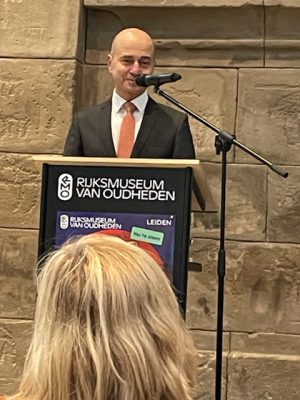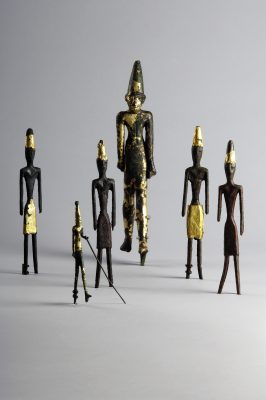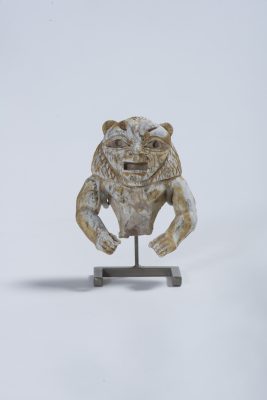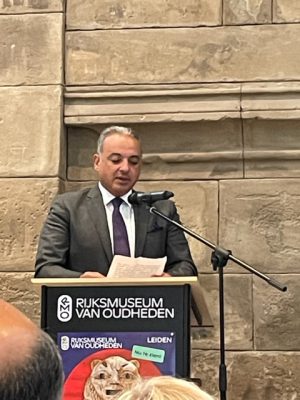On Thursday, 13 October 2022, the exhibition Byblos, the world’s most ancient port was officially opened in the Rijksmuseum van Oudheden in Leiden.
At the opening, more than hundred guests were present of which many ambassadors and we had the following speakers:
Mr. Wim Weijland, Director of the Dutch National Museum of Antiquities (RMO) Leiden; H.E. Mr. Abdel Sattar Issa, Ambassador of Lebanon to the Netherlands;
Mr. Lucas Petit, Head Collections and Research, RMO and the opening speech was given by the Minister of Culture of Lebanon, H.E. Judge Mohamad Wissam Al Mortada.
In his speech, the Ambassador of Lebanon, H.E. Mr. Abdel Sattar Issa, thanked the RMO and the Ministry of Culture of Lebanon for the beautiful exhibition. They managed to achieve it notwithstanding the great challenges Lebanon is facing since 2019, and said that the cooperation between the two institutions is not limited to this exhibition but extends to helping the renovation of the Museum of Byblos. He sincerely hopes that this cooperation will last in the future. About the exhibition, three general thoughts occurred to the Ambassador:
“The first one is rather an anecdote, a coincidence, a few days ago while visiting the Hortus Botanicusof the University of Leiden, right across the street from this Museum, I discovered a young beautiful specimen of the major actor of this exhibition, I mean the Cedrus Libani. It is because of this majestic tree, the national symbol of my country, that Byblos became prosperous in ancient times, by selling it to diverse Empires and Kingdoms of the region. The second idea was that trade is not only an exchange of goods. It has always been also an exchange of ideas, styles, even religious and social norms, simply a human exchange. Ancient Byblos was a living example of that. It was a melting pot of styles, gods and languages. The third idea is: when you see the traces of Byblos and its products in regions as distant as the Red Sea to the South East and the Agean Sea to the North West, when you remember that finally Europa, the daughter of the King of Tyr (some say Sidon) was kidnapped by the God Zeus from our shores (Heroditus mentions a less romantic version by saying it was merchants from Crete that kidnapped her), you cannot but wonder where the West ends and where the East starts? Are they not only intellectual constructs? Are we not all humans in the end? I think this is the main message of Lebanon.”
The Minister of Culture of Lebanon, H.E. Judge Mohamad Wissam Al Mortada
gave the following opening speech:
“It is my pleasure to inaugurate today the exhibition “Byblos, The Oldest Port in the World”, organized in collaboration with the RMO (Rijksmuseum van Oudheden). This joint project represents an exclusive and unique focus on Byblos, a millenary city, in the Dutch National Museum of Antiquities. The Ministry of Culture is particularly proud to focus on the 8000-year-old city of Byblos, Gbayl, listed, as well as four other Lebanese sites, Baalbeck, Tyre, Anjar and the Qadisha Valley, among the World Heritage Sites. With its 400 masterpieces on display, “Byblos, The Oldest Port in the World”, is not only presenting archaeological discoveries unearthed more than a hundred year ago, and showing recent outstanding findings. Rather, it focuses attention on the cultural enrichment of an ancient city throughout an archaeological collection and points out the significance of a unique National treasure.This exhibition is a fascinating journey across a geographic area and a historical context, where political, economic, religious and cultural life, are represented through powerful artistic expressions. It is about the understanding of Byblos, of its inhabitants throughout the ages, the landscape that shaped the city and the richness of its land and sea trade. Moreover, in old times, Byblos was a center, an “ancient capital” of the Levant as often stated, and the place where major innovative models were developed, such as the alphabet. The story of Byblos is today presented to both the Dutch and the International public.A project requires support and cooperation. In this regard, we are extremely grateful to the RMO. Our thanks go to all of whom helped bring this exhibition to fruition. From the Millennium city of Byblos, to the rich cultural heritage city of Leiden, we believe that this exhibition will develop shared understanding of each other’s values, beliefs and artistic traditions.”
The rich history of Byblos, a town situated on the coast of present-day Lebanon, began around 6500 BC with a simple fishing village that would grow into a prosperous city. Around 3000 BC, Byblos played an extraordinary role in the Mediterranean and Middle East as the world’s first international seaport, thanks to the trade in cedar wood. Egyptians, Assyrians, Babylonians, Phoenicians, Greeks and Romans left their mark on the city.
The World’s Most Ancient Port’ will present around 500 highlights from museums including the National Museum of Beirut, the Louvre and the British Museum, bearing witness to this archaeological and cultural richness. From simple fish hooks, anchors and clay tablets to golden weapons, colorful gemstone jewellery, a Roman mosaic and a bronze statue of Heracles. A key role is played by the kings, mythological heroes, merchants and fortune-seekers who visited and lived in Byblos. Particularly important were the city’s special ties with Egypt and the goddess known as the ‘Lady of Byblos’. For millennia, Byblos was the chief purveyor to the pharaohs and the most important trade hub in the Mediterranean.
Byblos’ wealth arose 5,000 years ago through trade with Egypt, among others, in products of the cedar tree from the mountains behind the city. These trees were famous for their straight trunks, which could reach 40 meters in height. The cedar wood and other precious materials from the Middle East, such as silver, wine and oil found their way to Egypt from Byblos. Byblos received precious stones, gold, linen and elephant ivory in return from Egypt and subsequently traded them with cities in Mesopotamia. The exhibition is bringing together the most beautiful artefacts from Byblos. The display includes finds from the royal tombs and the temples of Byblos, figurines of gods and goddesses, richly decorated weapons and jewellery. The distinctive bronze figurines of warriors, gods and animals, of which many hundreds have been found in Byblos, are especially striking. The exhibition is presented as a storybook, in which famous stories from Antiquity are set in the port, palaces and cedar forests of Byblos. For example, the Mesopotamian King Gilgamesh went to the Lebanese mountains to cut down cedar trees and the Egyptian Goddess Isis brought her deceased lover Osiris back to life in Byblos.
These days, the ancient city is a UNESCO World Heritage Site. Archaeological research is still ongoing. Finds from an elite burial complex recently excavated by the Lebanese Ministry of Culture/Directorate General of Antiquities and the Louvre will be on display in Leiden, with spectacular images of the excavation site. The exhibition was developed in partnership with the Lebanese Ministry of Culture/Directorate General of Antiquities. Through this partnership, the RMO is supporting the construction of a new archaeological museum and cultural center at the historical site of Byblos. This museum will open to the public in the spring of 2023
This international exhibition project features loans from numerous museums and collections: the Ministry of Culture/Directorate General of Antiquities (Lebanon); American University of Beirut Archaeological Museum (Beirut); Royal Museums of Art and History (Brussels); Bibliothèque Nationale de France (Paris); Musée du Louvre (Paris); British Museum (London); SMB, Vorderasiastisches Museum (Berlin); SMB, Ägyptisches Museum (Berlin), Roemerund Pelizaeusmuseum (Hildesheim); August Kestner Museum (Hannover); the Netherlands Institute for the Near East (NINO Leiden) and others. The exhibition was developed with the support of the Blockbusterfonds and the Vrienden Loterij, with thanks to the Lebanese Embassy (The Hague), the Dutch Embassy (Beirut) and Labrys Reizen.
The exhibition will be exposed until March 12, 2023.
For more information:
Rijksmuseum van Oudheden, Leiden,
www.rmo.nl



